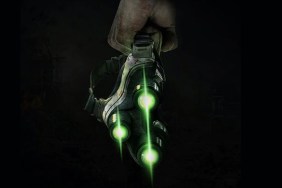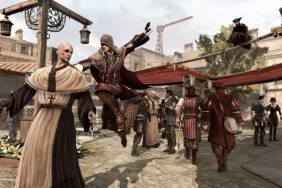You… are… a… TOY!
One of the perks of this kind of job—it easily offsets having to endure the occasional melted laptop battery, virus-riddled hard drive, Red Ring of Death and/or painful video-game viral-marketing campaign that attempts to be "eXtr33m"—is getting to visit the people and places responsible for the games, movies, and other media that populate our creative communal mind-space. Sometimes that means interviewing five scruffy-looking guys in T-shirts in an unassuming office-space… and sometimes it means spending the day at a larger-than-life place like Pixar Studios.
[image1]Shortly after being “the first people in the world” (their words) to see a screening of 15 minutes or so from Pixar’s upcoming Toy Story 3—before which we were carefully wanded and temporarily relieved of any and all recording-capable devices, as though we were embarking on a tour of Area 51—we got time with the game itself, at various gameplay stations arranged in a cartoonish, full-scaled Western town erected in Pixar’s large central atrium (in related news, Pixar currently has a cartoon Western town in their atrium).
Like so many other movie-licensed games, Toy Story 3 naturally has a single-player Story mode that loosely follows certain scenes from the movie: an extended and reasonably epic opening chase-segment that features Woody, his trusty steed Bullseye, and Buzz Lightyear trying to rescue a runaway frontier train full of pre-school toys from the evil, porky clutches of a gadget-happy Hamm. However, the real gameplay ‘meat’ of Toy Story 3, surprisingly, looks to be found in the game’s open-ended Toy Box mode.
When the Pixar and Avalanche folks put their heads together to work on the TS3 game, they arrived at at least one definite, common inspiration: They wanted to make a game that could in some sense embody and reward the way an imaginative child plays with his or her real-world toys. Namely, with the the kind of carefree, mix-and-match abandon displayed by the human character Andy; like many kids, Andy wouldn’t think twice about having his pull-string cowboy sheriff join forces with a powered-armor Space Ranger, to rescue Little Bo Peep (and perhaps a borrowed Barbie or two) from a makeshift prison cobbled together from wooden blocks and Legos and guarded by squeezy, three-eyed space-aliens. And patrolled by Hot Wheels, and Army Men. Commanded by a nefarious Speak ‘n Spell. Whatever works, right?
To this end, the Toy Box mode—which is effectively separate from the more directly movie-inspired Story levels—gives players free, sandbox-style run of an entire play-space town to which they can add structures, and the whole of which they can customize with a variety of paint, texture, building-trim, and other options. In my session, I stumbled rather early upon a hidden underground-mine section and found some truly garish, hideous-looking, clown-fish ‘themes’ from Finding Nemo—and thence proceeded to inflict, upon every building-facade in town, a nightmarish taste-job that would make John Waters claw his own eyes out.
[image2]As players roam through and around the surrounding environs of their town, they can find tons of quest, side-challenges, and mini-missions either by talking to key Toy Story characters or just by wandering around and seeing what they come across. It’s a complete free-roaming, non-linear sort of experience, filled with little secrets, experiments, and sometimes just straight-up gags. After you scour the surrounding badlands for a quartet of missing cows and return them to their corral (by drop-kicking them down into said target-pen from nearby overhanging ledges, if necessary), maybe you’ll pick up a few kegs of TNT and chuck them at the beckoning targets on a mountainside… the resultant blasts creating a ‘Mount Toymore’, now prominently featuring the large, chiseled-rock faces of Woody, Buzz, and Jessie.
(If that’s too subtle for you, keep your eyes peeled for the wing of Blue Angels-style jet plans that soon streak over your new creation, pluming bands of colored smoke all over the immediate airspace).
Another self-contained challenge area we saw had Woody driving around in a toy sports car—purchased, like so many other objects populating the game, at a convenient automated Al’s Toy Barn kiosk. The ‘track’ for this area consisted of a series of shallow desert trenches interspersed with gently-curved walls and ramps, effectively making a sort of sprawling skate-park for Woody’s set of wheels.
In addition, various colored rings which players can jump their vehicles through have instant, vehicle-modifying effects. One color would shrink the vehicle in question down to an even tinier size (leaving a now-outsized Sheriff Woody sitting on a set of wheels the approximate proportionate size of an RC car), while the other would instantly grow the vehicle to monster truck-like proportions, goofy, oversized wheels and all. In other sections of the game, flinging similarly-colored globs of goo directly at other characters would produce the same size-changing effects for a limited period of time. Even bigger T-Rex, anyone?
[image3]This is your Toy Box, so you make the stylistic rules. As your rack up a supply of the game’s readily-available gold, you can purchase entire new thematic ‘Playset’ additions to the outskirts of your play-town. One such Playset brings in a Space-themed port, along with an influx of Squeaky Space Aliens and flying saucers that proceed to abduct livestock about town for no adequately-explored reason). Another is Sid’s Haunted House, which also presumably yields some of the freaky, cobbled-together Frankentoys from the first movie. Still another Playset apparently involves pirates—and I think we all know that can only make a game better.
Loosely connecting the smaller, more movie-based Story mode—about four hours of gameplay—with the larger, more open-ended Toy Box mode is an interface resembling a child’s board game. It’s not clear yet exactly how or to what extent the film-based and open-ended Toy Box modes are actively interrelated, but that very first train-rescue mission mentioned above introduces gameplay-control tutorials like Woody’s Shoulder Dash attack, a scheme for targeting and throwing colored plastic balls, and a very entertaining method of picking up and drop-kicking the game’s smaller, more-annoying foes.
Toy Story 3 will be available for PS3, X360, PSP, DS, and iPhone, and PS3 players will have the exclusive ability to use Emperor Zurg as a playable character. It’s looking, naturally, as family-friendly as you might expect, but the high quality of the character models and animation—and of course the inclusion of the hefty Toy Box mode—makes it pretty clear that the developer is interested in elevating the experience here beyond the typical, kids-only, cookie-cutter, awkwardly-recreate-key-scenes-in-the-movie dodge that still plagues far too many movie-licensed titles. We’ll see if Buzz, Woody, and Jessie can play well with a broader age-range of gamers, when Toy Story 3 hits the shelves of an Al’s Toy Barn near you this June.







